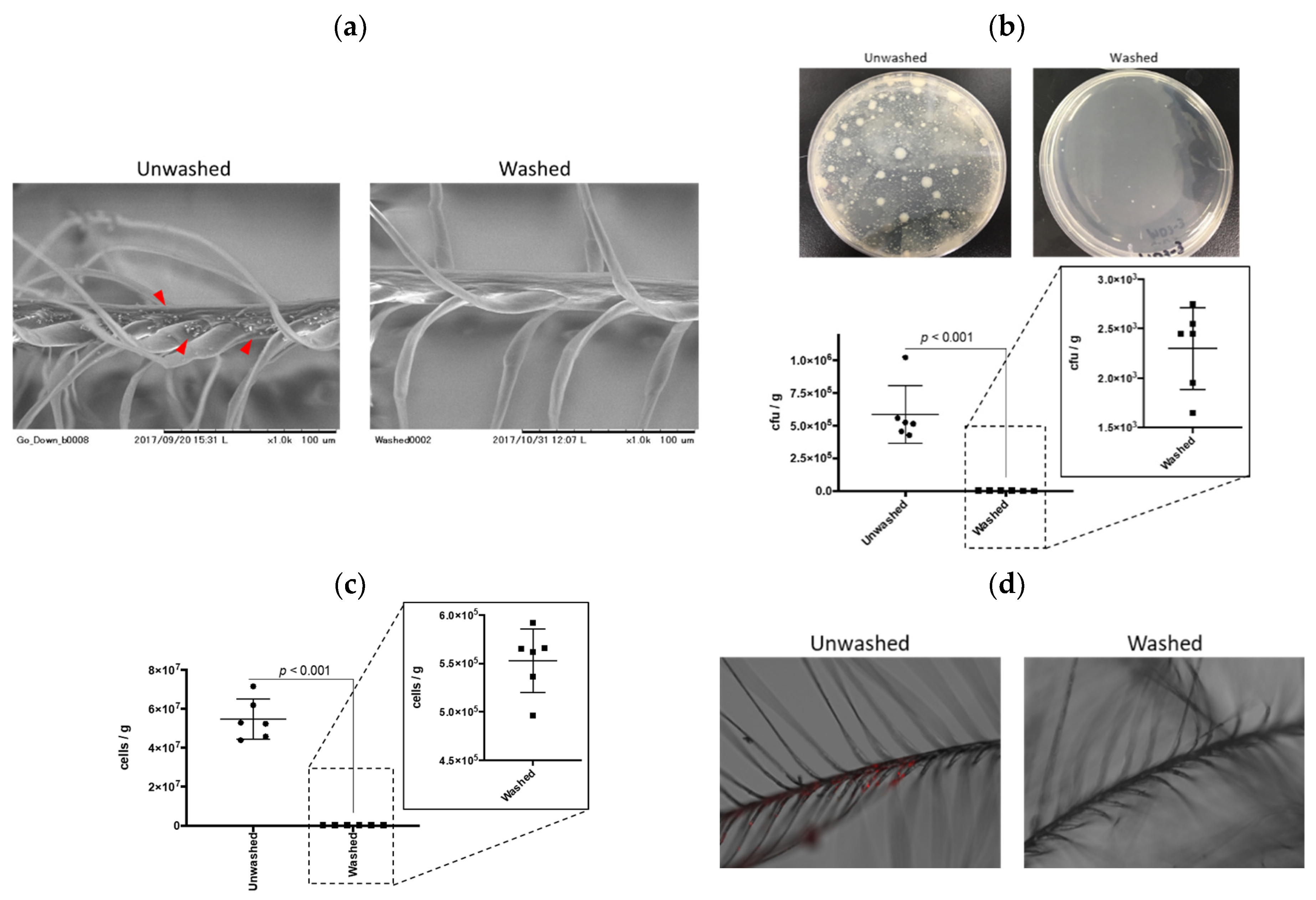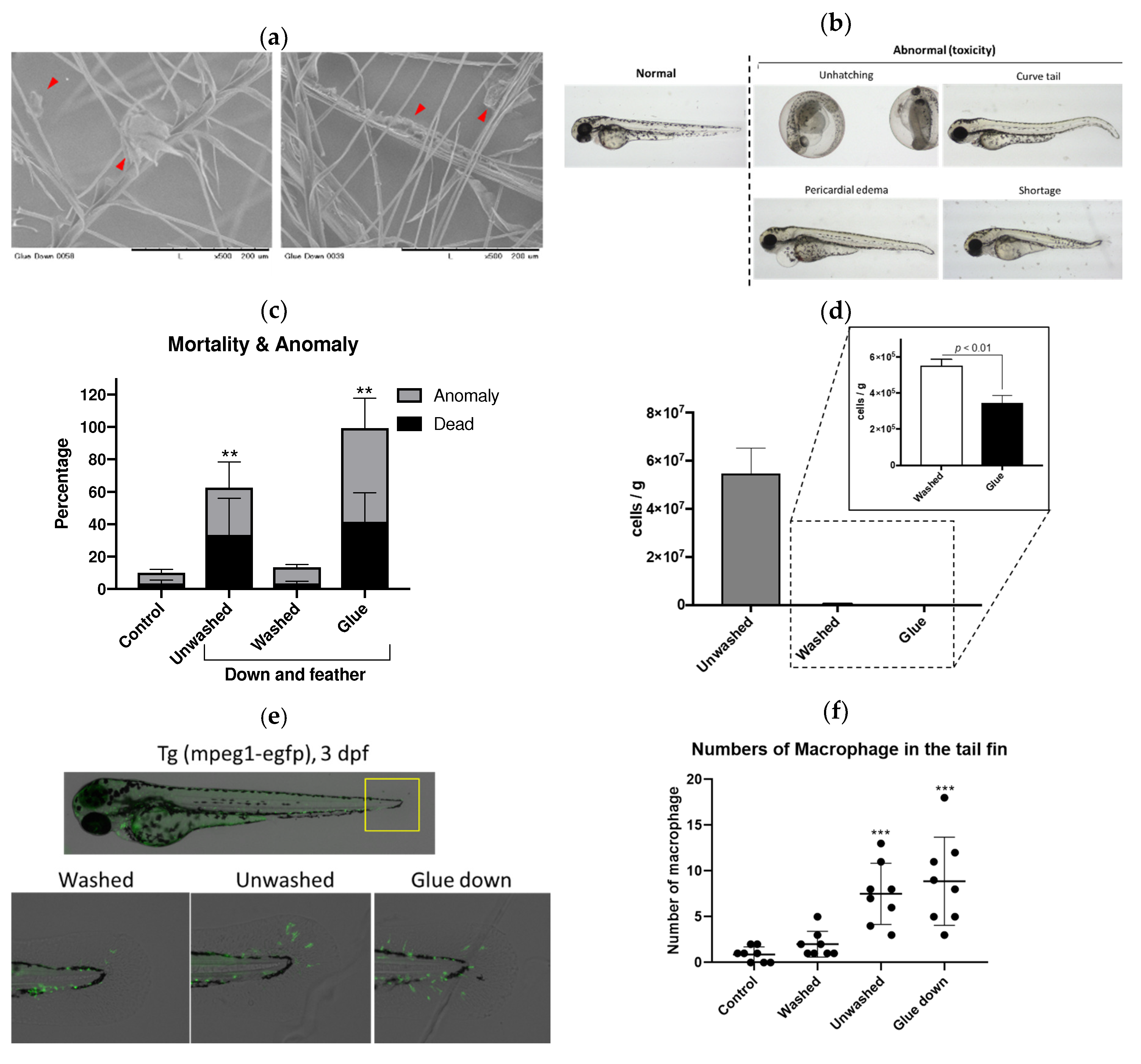An Integrative Evaluation Method for the Biological Safety of Down and Feather Materials
Abstract
1. Introduction
2. Results and Discussion
2.1. qPCR Quantification for Contaminated Bacteria in Down and Feather Samples
2.2. Compositions of Contaminated Bacteria in Down and Feather Samples
2.3. In Vivo Toxicity of Down and Feather Samples
3. Materials and Methods
3.1. Scanning Electron Microscopy of Down and Feather Samples
3.2. Zebrafish
3.3. Bacterial Examination
3.4. Escherichia coli Exposure
3.5. qPCR
3.6. 16S rRNA Sequencing
3.7. Zebrafish Embryo Toxicity Test
3.8. Quantification of Silicon Compounds in Down and Feather Samples
3.9. Statistics
4. Conclusions
Supplementary Materials
Author Contributions
Funding
Acknowledgments
Conflicts of Interest
Abbreviations
| EGFP | Enhanced green fluorescent protein |
| E. coli | Escherichia coli |
| hpf | Hours post fertilization |
| qPCR | Quantitative polymerase chain reaction |
| ZFET | Zebrafish embryo toxicity test |
References
- Kilpiö, K.; Mäkinen-Kiljunen, S.; Haahtela, T.; Hannuksela, M. Allergy to feathers. Allergy 1998, 53, 159–164. [Google Scholar] [CrossRef] [PubMed]
- Clarke, N. Down Pillow Allergy Symptons. In Livestrong.com. 2017. Available online: https://www.livestrong.com/article/258868-down-pillow-allergy-symptoms/ (accessed on 20 March 2019).
- Kim, T. Glue Down Analysis. In Proceedings of the International Down and Feather Bureau, Tallinn, Estonia, 3 June 2018. [Google Scholar]
- Hill, A.J.; Teraoka, H.; Heideman, W.; Peterson, R.E. Zebrafish as a model vertebrate for investigating chemical toxicity. Toxicol. Sci. 2005, 86, 6–19. [Google Scholar] [CrossRef] [PubMed]
- Inoue, A.; Nishimura, Y.; Matsumoto, N.; Umemoto, N.; Shimada, Y.; Maruyama, T.; Kayasuga, K.; Morihara, M.; Katagi, J.; Shiroya, T.; et al. Comparative study of the zebrafish embryonic toxicity test and mouse embryonic stem cell test to screen developmental toxicity of human pharmaceutical drugs. Fundam. Toxicol. Sci. 2016, 3, 79–87. [Google Scholar] [CrossRef]
- Chang, J.; Ichihara, G.; Shimada, Y.; Tada-Oikawa, S.; Kuroyanagi, J.; Zhang, B.; Suzuki, Y.; Sehsah, R.; Kato, M.; Tanaka, T.; et al. Copper Oxide Nanoparticles Reduce Vasculogenesis in Transgenic Zebrafish Through Down-Regulation of Vascular Endothelial Growth Factor Expression and Induction of Apoptosis. J. Nanosci. Nanotechnol. 2015, 15, 2140–2147. [Google Scholar] [CrossRef] [PubMed]
- Ultee, A.; Souvatzi, N.; Maniadi, K.; König, H. Identification of the culturable and nonculturable bacterial population in ground water of a municipal water supply in Germany. J. Appl. Microbiol. 2004, 96, 560–568. [Google Scholar] [CrossRef] [PubMed]
- Childers, N.K.; Osgood, R.C.; Hsu, K.L.; Manmontri, C.; Momeni, S.S.; Mahtani, H.K.; Cutter, G.R.; Ruby, J.D. Real-time quantitative polymerase chain reaction for enumeration of Streptococcus mutans from oral samples. Eur. J. Oral Sci. 2011, 119, 447–454. [Google Scholar] [CrossRef] [PubMed]
- Zemanick, E.T.; Wagner, B.D.; Sagel, S.D.; Stevens, M.J.; Accurso, F.J.; Harris, J.K. Reliability of quantitative real-time PCR for bacterial detection in cystic fibrosis airway specimens. PLoS ONE 2010, 5, e15101. [Google Scholar] [CrossRef] [PubMed]
- Yanagihara, K.; Niki, H.; Baba, T. Direct PCR amplification of the 16S rRNA Gene from single microbial cells isolated from an Antarctic iceberg using laser microdissection microscopy. Polar Sci. 2011, 5, 375–382. [Google Scholar] [CrossRef]
- Busquet, F.; Strecker, R.; Rawlings, J.M.; Belanger, S.E.; Braunbeck, T.; Carr, G.J.; Cenijn, P.; Fochtman, P.; Gourmelon, A.; Hübler, N.; et al. OECD validation study to assess intra- and inter-laboratory reproducibility of the zebrafish embryo toxicity test for acute aquatic toxicity testing. Regul. Toxicol. Pharmacol. 2014, 69, 496–511. [Google Scholar] [CrossRef] [PubMed]
- Ellett, F.; Pase, L.; Hayman, J.W.; Andrianopoulos, A.; Lieschke, G.J. mpeg1 promoter transgenes direct macrophage-lineage expression in zebrafish. Blood 2011, 117, e49–e56. [Google Scholar] [CrossRef] [PubMed]
- Xu, H.; Dong, X.; Zhang, Z.; Yang, M.; Wu, X.; Liu, H.; Lao, Q.; Li, C. Assessment of immunotoxicity of dibutyl phthalate using live zebrafish embryos. Fish Shellfish. Immunol. 2015, 45, 286–292. [Google Scholar] [CrossRef] [PubMed]
- Ibarbalz, F.M.; Figuerola, E.L.; Erijman, L. Industrial activated sludge exhibit unique bacterial community composition at high taxonomic ranks. Water Res. 2013, 47, 3854–3864. [Google Scholar] [CrossRef] [PubMed]



© 2019 by the authors. Licensee MDPI, Basel, Switzerland. This article is an open access article distributed under the terms and conditions of the Creative Commons Attribution (CC BY) license (http://creativecommons.org/licenses/by/4.0/).
Share and Cite
Kawada, T.; Kuroyanagi, J.; Okazaki, F.; Taniguchi, M.; Nakayama, H.; Suda, N.; Abiko, S.; Kaneco, S.; Nishimura, N.; Shimada, Y. An Integrative Evaluation Method for the Biological Safety of Down and Feather Materials. Int. J. Mol. Sci. 2019, 20, 1434. https://doi.org/10.3390/ijms20061434
Kawada T, Kuroyanagi J, Okazaki F, Taniguchi M, Nakayama H, Suda N, Abiko S, Kaneco S, Nishimura N, Shimada Y. An Integrative Evaluation Method for the Biological Safety of Down and Feather Materials. International Journal of Molecular Sciences. 2019; 20(6):1434. https://doi.org/10.3390/ijms20061434
Chicago/Turabian StyleKawada, Toshikatsu, Junya Kuroyanagi, Fumiyoshi Okazaki, Mizuki Taniguchi, Hiroko Nakayama, Narumi Suda, Souta Abiko, Satoshi Kaneco, Norihiro Nishimura, and Yasuhito Shimada. 2019. "An Integrative Evaluation Method for the Biological Safety of Down and Feather Materials" International Journal of Molecular Sciences 20, no. 6: 1434. https://doi.org/10.3390/ijms20061434
APA StyleKawada, T., Kuroyanagi, J., Okazaki, F., Taniguchi, M., Nakayama, H., Suda, N., Abiko, S., Kaneco, S., Nishimura, N., & Shimada, Y. (2019). An Integrative Evaluation Method for the Biological Safety of Down and Feather Materials. International Journal of Molecular Sciences, 20(6), 1434. https://doi.org/10.3390/ijms20061434





